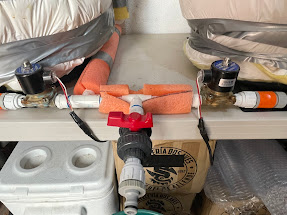 |
| open fermenter also know as a garbage can |
Each outlet is split into two zones: the top socket handles cooling, and the bottom socket handles heating. When a controller senses the beer creeping above the set temp, it energizes the top outlet—simultaneously activating a pump and opening a solenoid valve. That’s the magic moment: glycol is unleashed, rushing through a garden hose coiled around a garbage can fermenter, drawing out the excess heat and returning to the glycol reservoir. If the beer drops below target? The bottom socket kicks on a heating pad tucked beneath the can, gently nudging the temperature back up.
It’s a tightly orchestrated dance of sensors, solenoids, and controlled chaos—all in the name of perfect fermentation.
 |
| Fermenter with water heater insulation |
So yes—at first glance, and second for that matter, the whole setup might look like something cobbled together in a backwoods lawmower shed. It’s not shiny, it’s not stainless, and it sure won’t be winning any design awards. But what it is—is effective. This system controls fermentation temperatures with surprising precision, all at a fraction of the cost of the sleek, space-age hardware you’ll currently find in your online homebrew outlet. Case in point? I was able to crash cool my last India Pale Lager down to 40°F overnight—no sweat, no drama. Just clever engineering on a budget.
Cheers!





No comments:
Post a Comment